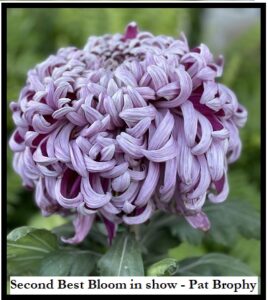MARCH TO DO LIST (edited from DRS 2-21-05)
1. Clean pots and gather materials for potting:
· For soilless growers, supplies include soilless mix, Peters 9-45-15 fertilizer, and optionally, ¼ inch screened pumice, perlite or grit. Most of our growers use the M & R Soilless potting mix sold by the club. Addition of the pumice perlite or grit is not necessary for this stage. Generally the pumice etc. is added for the 9-inch potting. Some also add the pumice to the mixture for the 6-inch potting.
· For McGlashen soil mixes, you will need good garden loam; pumice, perlite or grit; and leaf mold or course greenhouse peat, plus well composted manure, steamed bone meal, slacked or hydrated lime and a good dry rose fertilizer such as 4-10-8. See your copy of the McGlashen book for details.
2. Pot mums into 4 or 6-inch pot:
· Clay pots are recommended when possible for the 4 or 6 inch potting as these pots breathe and dry out faster during cool March and April days.
· Wash used pots in a bleach/water solution, i.e. 2 teaspoons per gallon of water. Then rinse in fresh water. Let the cleaned pots set in the clear water for 3 or 4 minutes to clear out the bleach. Change the rinse water occasionally to clear out the bleach from previous rinses.
· Pot on when the ring of roots around the bottom of the pot is substantial. Do not compact the mix and leave room at the top for watering.
3. Move pots outdoors:
· After mums have become well established in the new pots (1-2 weeks) move mums outdoors or to cold frame to slow the foliage growth and toughen up the plants. The desirable ambient temperature is 50 to 60 degrees.
· To keep roots warm and at a stable temp, bury the pots in the soil or in a layer of compost or manure. Six inches is a good depth for the compost or manure. A cold frame is the best solution for this stage!
· Lacking a good sunny location, B-9 is a growth retardant spray mix that tends to help plants from getting too leggy. It is available through the club.
4. Stopping Dates:
· Review stopping dates and stop mums as their stopping dates arrive. Very few varieties require pinching in March unless a double pinching regimen is being followed (Phil Houghton March 15 and May 15 for example).
· Refer to the various ECA lists of stopping dates. Copies of a stopping date list will be available at the meeting.
5. Keep growing vigorously:
· Water as needed, but keep relatively dry
· Spray or control aphids
· Fertilize soil less plants with 9-45-15 or Miracle Grow solution starting the 2nd or 3rd week after potting. Use fertilizer at ½ strength that is approximately ½ teaspoon/gallon.
Begin culling process in March to get to the final growing group. Send surplus
quality plants to plant sales or share with other ECA members. Throw away poor
plants and damaged or diseased plants.




